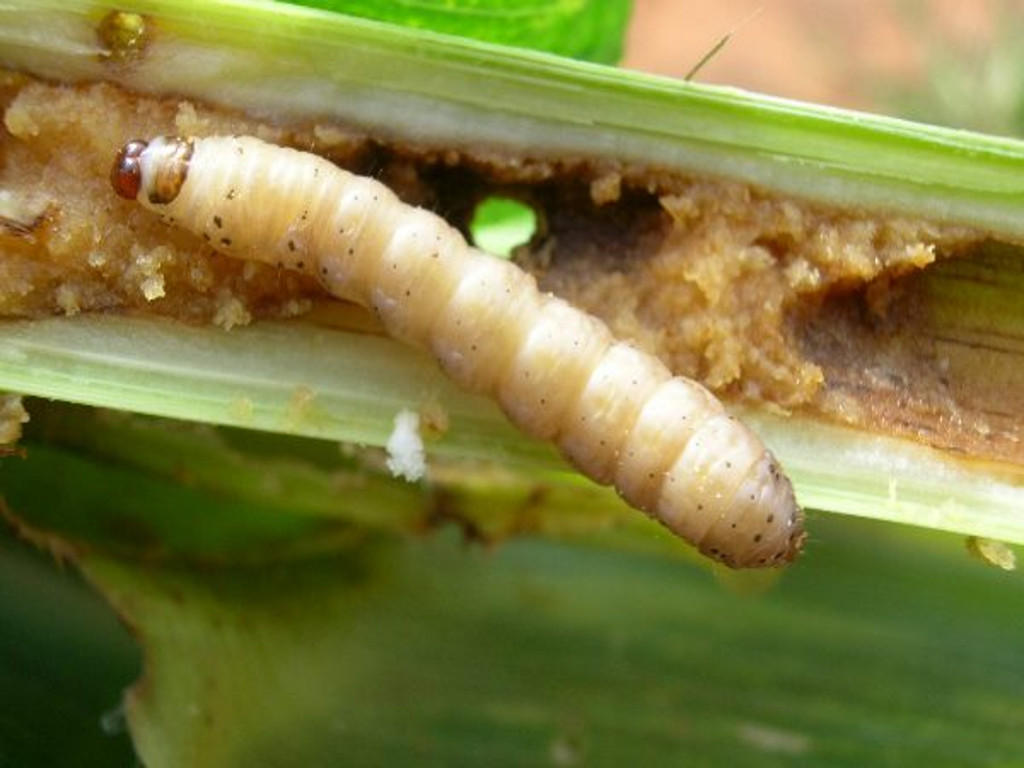Know your pest: Maize Stem Borer Complex
Lepidopteran pests such as stem borers cause major damage in maize fields, resulting in significant yield losses. There are three main stem borer species that attack maize in South Africa. These include the African maize stalk borer (Busseola fusca), Chilo borer (Chilo partellus) and the pink stem borer (Sesamia calamistis).

African Maize Stalk Borer
African maize stalk borer moth flights begin in October and occur throughout South Africa, except the coastal regions and lowveld areas. Three moth flights occur per year with the middle one the largest. Under favourable conditions, the life cycle can be completed in 7 to 8 weeks. Female moths lay egg batches in rows (10 to 80 eggs) between the stem and leaf sheath, which take 7 to 9 days to hatch. The egg batches are white when first laid but darken as they age. The first larval instars migrate into young leaf whorls to feed producing characteristic small holes or “window panes”, or transparent leaf patches. Young larvae are dark brown in colour and become lighter as they mature with characteristic small black spots along the body. Although older larvae can tunnel extensively into the stems, they do prefer the tasselling stage. Larval feeding lasts for 4 to 6 weeks before pupating, after which adult moths soon emerge and repeat the cycle again.
Damage
African maize stalk borer is regarded as the most serious stem borer pest of maize and poses additional risks to humans and animals as crop damage due to larval feeding often increases susceptibility to secondary infections such as Fusarium rot. Larval feeding on the growing points of plants results in die-off of central leaves in the whorl, which dry out and cause withered “dead heart” symptoms. Due to tunnelling by adult larvae, stems are often weakened as they are hollowed out and become filled with frass, causing them to break under windy conditions. Larvae can also bore into the maize cobs and feed on the seed leaving visible frass deposits.
Chilo Borer
Chilo borer occurs mainly in the maize triangle and low-lying warmer areas of Mpumalanga, Limpopo, Springbuck flats, Makatini flats and areas in Kwazulu-Natal. The primary host of Chilo borer is sorghum, with maize being secondary. The life cycle of Chilo borer is much shorter and is completed within 3 to 4 weeks. Moths emerge in September, with females laying egg batches (up to 500 eggs) on the upper and underside of young seedling leaves. Egg batches are white, oval, flat and overlapping, similar to roof tiles, and hatch after 5 to 7 days. Larvae are creamy white in colour with characteristic dark spots along the back, which is why Chilo borer is also known as the spotted stemborer. Emerging larvae crawl towards the whorl and spread to nearby plants on thin silk threads. Larval feeding lasts 3 to 4 weeks in the whorl where they feed on young rolled up leaves, before leaving this area to penetrate the stem for pupation. Larvae overwinter in plant stubbles and as temperatures increase after winter, moths emerge after a short 5 to 7 day pupal period. Due to the shorter duration of the larval stage, less feeding and shorter life cycle of Chilo borer, it is regarded as a less serious pest for maize when compared to African stalk borer.
Damage
Includes small holes or “windows” in the leaves as they grow out due to larval feeding in the whorl as well as extensive tunnelling in stems and maize cobs by older larvae. Damage caused by Chilo borer is very similar to that of African stalk borer.
Sesamia or Pink Stem Borer
Sesamia, better known as the pink stem borer, occurs mainly along the coastal regions, the lowveld of Limpopo and Mpumalanga, North West and parts of the maize triangle. Completion of the pink stem borer life cycle varies between 6 to 10 weeks. Similar to Chilo borer, pink stem borers start moth flights as early as September and have five overlapping generations per year. Moths are active during night-time and live between 2 to 14 days. Moths need early maize plantings for egg laying and survival, even though grass is sometimes preferred. Female moths lay large groups (>100) of eggs mainly between leaf sheaths or close to maize cobs. A single female can produce up to 1 000 eggs. Eggs are creamy white in colour but darken before hatching in 6 to 9 days, depending on the host plant and temperatures. Emerging larvae immediately penetrate into stalks or maize cobs where they continue to feed and exit the plant if it’s no longer an adequate source of food. Larvae are usually creamy white in colour with a distinctive pink colouring. The larval stage lasts between 3 to 6 weeks, following which pupation occurs within the stem or between leaves.
Damage
In the summer rainfall area infestations are more severe during October/November in seedlings and in February/March when cobs are present. The first visible symptoms include damage to the growing points (dead hearts) because larvae bore directly into the stem without damage to the whorl leaves. Early maize planting under pivot irrigation is very susceptible to pink stem borer attack.One of the main options for control is the use of chemical applications with products registered specifically against stalk borers. It is important however, that chemical control strictly adheres to responsible use which includes taking the necessary safety measures, alternating chemical groups and spraying at recommended dosage rates as per product label. Planting maize cultivars modified with insect resistant technology (i.e. Bt crops) is another option for protection against infestations by stalk borers. For successful stalk borer control and to manage insect resistance efficiently, it is crucial that the area planted with Bt maize includes the planting of a mandated refuge. Cultural control options include earlier planting dates in winter or early in spring to expose overwintering larvae or cover pupae with soil, as moths are not equipped to reach the soil surface when they hatch. Other measures include control of volunteer maize plants, selection of varieties with inbred resistance, allowing beneficial insects to play a role and regular scouting of fields to identify stalk borer infestations earlier rather than later.
Loading
